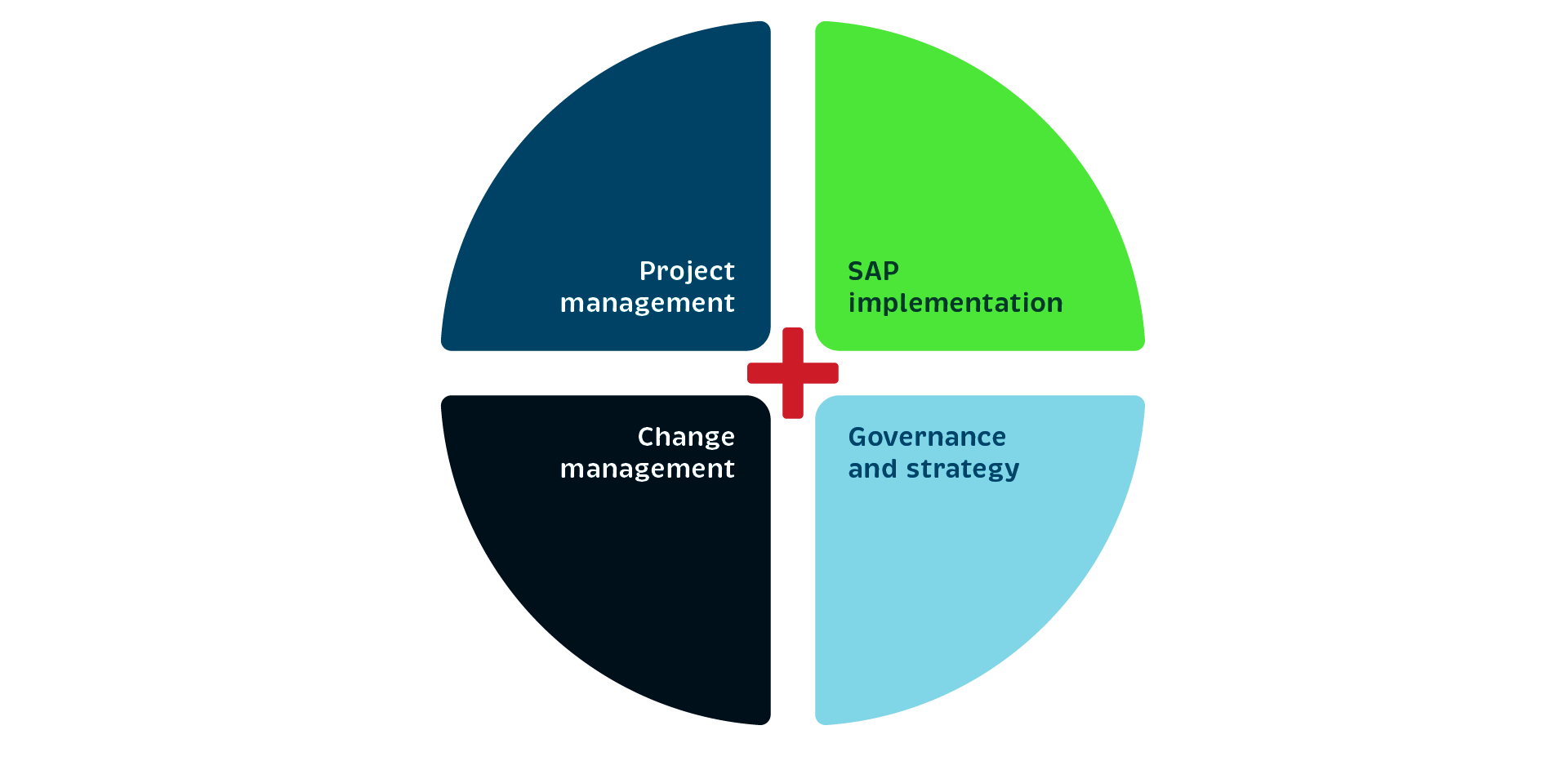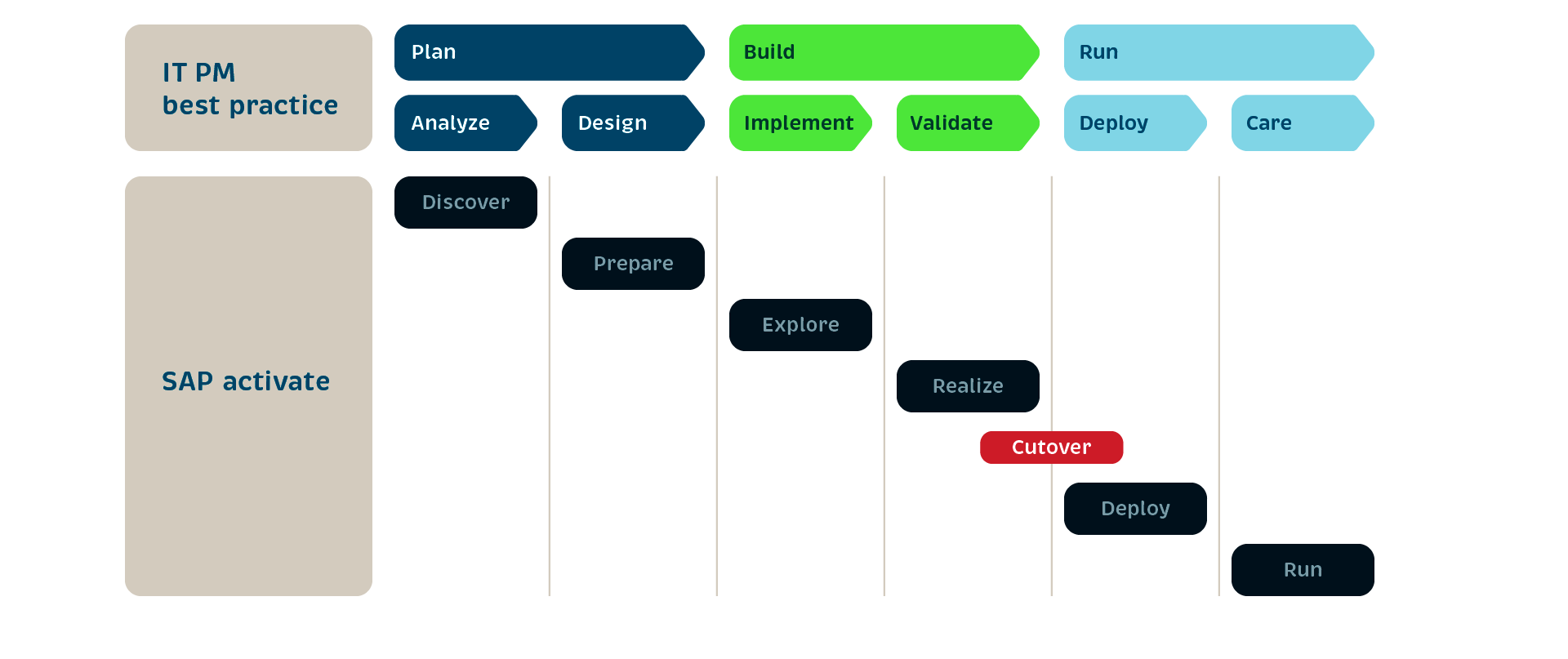Anyone implementing SAP S/4HANA is changing far more than just systems. The transition affects processes, roles, and the shared understanding of collaboration — in short: the entire organization. ERP projects reach deep into technological, structural, and cultural areas. In Part 1, we explored common pitfalls and key success factors that have proven effective in practice. However, these only have an impact if they are consistently translated into action.
This is precisely where a methodical approach becomes crucial. Only the coordinated interaction of technical expertise, professional project management, and effective change management creates the conditions for a transformation that succeeds not only technically but is also embraced organizationally.
In practice, the challenges often lie less in the technology and more in the organizational environment: missing roles, overloaded teams, or lack of acceptance can slow progress. What’s needed are clear structures, well-defined responsibilities, and an approach that fits the company culture while remaining flexible.
Four Areas of Action for Successful Implementation
To successfully implement SAP migration projects, more is needed than just technology and project plans. What’s crucial is a methodological framework that systematically addresses both the technical and organizational dimensions. Four key areas of action must be addressed:
Would you like me to continue by translating and elaborating on these four fields if you provide them?

1. Project management
Building a resilient project structure, selecting suitable methods (classic, agile, or hybrid), and managing time, quality, and budget.
2. SAP implementation
Technical implementation based on the SAP architecture and migration paths, taking into account individual business cases and existing system landscapes.
3. Change management
Support throughout all project phases. Communication, training, involvement, and support of the teams.
4. Governance und strategy
Ensuring that all measures contribute to overarching goals. Close coordination between project management, departments, and corporate leadership.
As much as necessary, but as little as possible: SAP Activate as a foundation, enhanced with project-specific practical experience
At Campana & Schott, we work with a model that incorporates the aforementioned areas of action and is also aligned with SAP Activate.
SAP Activate provides companies with a solid methodological foundation for SAP transformations. The framework combines best practices, clearly structured phase models, and preconfigured tools to facilitate onboarding and provide guidance.
However, in complex project situations, this foundation alone is often not enough. Activate is intentionally designed to be generic and must be adapted to the specific starting point — especially in cases of historically grown system landscapes, cross-departmental requirements, and limited internal resources. This is particularly true for companies facing their first major transformation, where experience with the model is often lacking.
We have a deep understanding of the SAP Activate framework, know how to select the appropriate areas of action, and complement them with our own proven project management and change management approaches. This creates a methodology that offers both structure and flexibility, and can be precisely tailored to the specific needs of each organization.

Our SAP roadmap guides projects through four clearly defined steps. It is fully compatible with SAP Activate and enhanced by our best practices from numerous SAP transformation initiatives.
- Plan
Joint development of project goals, timelines, risks, and framework conditions. - Build
Technical implementation of the agreed solution, including configuration, integration, and operational testing. - Cutover Management
Planning and execution of the transition from the legacy system to the new environment — one of the most critical moments in the project. - Run
Transition to regular operations with performance testing, handover, and support for business units.
Governance and strategic steering form the overarching framework throughout the entire project. They ensure that decisions align with corporate goals, resources are prioritized effectively, and all stakeholders are clearly involved. This includes a transparent decision-making framework, a shared vision, aligned KPIs, and early involvement of management, IT, and business departments.
Throughout all phases, we also secure the project with active change management — through communication, coaching, and close support of key personnel within the organization.
The cutover phase is particularly sensitive. Only with clear planning, stakeholder alignment, defined roles, and comprehensive simulation testing can risks be minimized and a successful go-live achieved.
Conclusion: Structure Creates Confidence, Execution Makes the Difference
A SAP transformation cannot succeed through technology alone. What truly matters is the interplay of expertise, project structure, and the ability to drive change. Those who rely on a clear, adaptable approach reduce complexity, increase acceptance, and create real impact.
Read Part 1 of our series to learn which pitfalls to watch out for during your S/4HANA migration.



